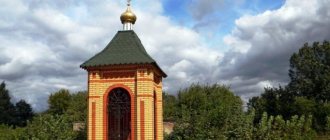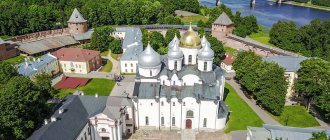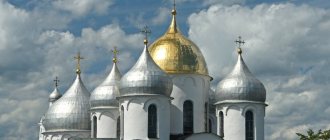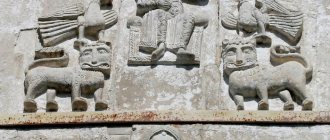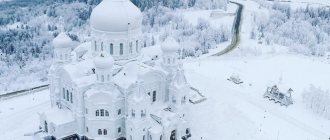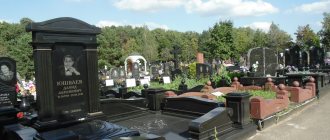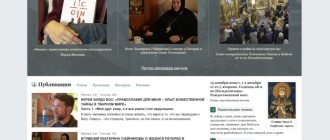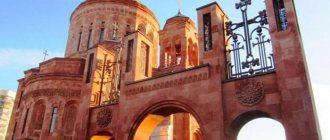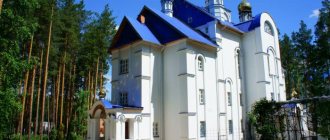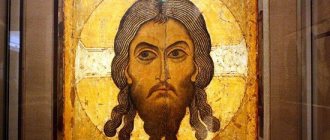Why do believers build temples? Why are there such a large number of them scattered throughout the Orthodox Land? The answer is simple: everyone’s goal is the salvation of the soul, and achieving it is impossible without visiting church. She is a hospital where the soul is healed from sinful falls, as well as its deification. The structure of the temple and its decoration allow the believer to plunge into the divine atmosphere and become closer to the Lord. Only a priest who is present in the temple can perform the rites of baptism, wedding, and absolution. Without services and prayers, a person cannot become a child of God.
Orthodox church
An Orthodox church is a place where they serve God, where there is an opportunity to unite with him through such sacraments as baptism and communion. Believers gather here to pray together, the power of which everyone knows.
The first Christians had an illegal status, so they did not have their own churches. For prayers, believers gathered in the houses of community leaders, synagogues, and sometimes in the catacombs of Syracuse, Rome, and Ephesus. This lasted for three centuries until Constantine the Great came to power. In 323 he became the full-fledged emperor of the Roman Empire. He made Christianity the state religion. Since then, the active construction of temples, and later monasteries, began. It was his mother, Queen Helen of Constantinople, who initiated the construction of the Church of the Holy Sepulcher in Jerusalem.
Since then, the structure of the temple, its interior decoration, and architecture have undergone significant changes. In Rus', it became customary to build cross-domed churches; this type is still relevant today. An important detail of any temple are the domes, which are crowned with a cross. Already from afar you can see the house of God from them. If the domes are decorated with gilding, then they glow under the rays of the sun, symbolizing the fire burning in the hearts of believers.
Services in the Temple
The schedule of services can be found at the Old Town gate leading to the Christian Quarter. At the Holy Sepulcher, liturgies are served alternately.
Greek Orthodox services:
- on Saturdays - at 23:00 (winter) and midnight (summer);
- on other days - at 23:30 (winter) and 00:30 (summer).
From 03:00 the liturgy is celebrated by the Armenian Church, and from 06:00 by Catholics.
The Divine Liturgy in the Katholikon begins at 07:00 (winter) and 08:00 (summer).
Internal organization
The internal structure of the temple necessarily symbolizes closeness to God, is endowed with certain symbolism, decoration, and serves to satisfy the goals of Christian worship. As the Church teaches, our entire material world is nothing more than a reflection of the spiritual world, invisible to the eye. The temple is an image of the presence of the Kingdom of Heaven on earth, respectively, the image of the King of Heaven. The structure of an Orthodox church, its architecture, and symbolism make it possible for believers to perceive the temple as the beginning of the Kingdom of Heaven, its image (invisible, distant, divine).
Like any building, a temple must carry the functions for which it is intended, satisfy needs and have the following premises:
- For clergy who conduct services.
- For all believers present in the church.
- For repentants and those preparing to be baptized.
Since ancient times, the temple has been divided into three main parts:
- Altar.
- The middle part of the temple.
- The narthex
The temple is further divided into the following parts:
- Iconostasis.
- Altar.
- Throne.
- Sacristy.
- Mountain place.
- Pulpit.
- Solea.
- Sexton.
- Choirs.
- The porch.
- Candle boxes.
- Bell tower.
- Porch.
Architectural features of temple buildings
The temple is a metaphorical image of Noah's Ark, which was built to save humanity from terrible destruction. Since the birth of Christianity, churches have been built for the laity so that they can save their souls from sin. Almost every day great Sacraments, divine services or holiday services are held in churches, and any baptized person can take part in the sacred rite.
External structure of an Orthodox church
Traditionally, temple buildings are built with the main gate to the west and the altar to the east. This arrangement symbolizes the divine path from darkness to light, along which God leads every believer in Him. In addition, the newly erected cathedral is consecrated and named after some saint or in honor of an Orthodox festival (Pokrovsky, St. Isaac's, Vladimir, etc.).
Temple forms
There are four types of buildings in temple architecture:
- cruciform - symbolizes the Cross on which Jesus Christ was crucified, saving all humanity by His sacrifice;
- rectangular - is an allegory of Noah’s Ark, as a symbol of salvation;
- round - marks the infinity of the Orthodox Church;
- eight-pointed - means the Star of Bethlehem, lit in the sky on Christmas night.
Today, almost all cathedrals are built in the shape of a rectangle or a cross, but earlier architects actively built churches according to other geometric designs.
Temple dome
A mandatory architectural element of all Orthodox churches is a dome topped with a cross. The number of goals is always odd and can reach thirteen units:
- one means the unity of the Lord;
- three are a sign of the Holy Trinity;
- five - signify the Savior and the four apostles who wrote the Gospel;
- seven - according to the number of main church Sacraments;
- thirteen - symbolize Jesus Christ and His twelve disciples.
Types of church domes
Church bells
The structure of any Orthodox cathedral is not complete without bells. They are the ones who notify the laity about the most important events in church life. The belfry, as a rule, is erected above the main entrance or next to the temple building. By the nature of the bell ringing you can determine its meaning:
- blagovest - a slow, measured ringing, calling for great holidays or solemn services;
- trezvon - ringing of all the bells, as a symbol of joy from the Orthodox festival;
- chime - an alternating ringing, signifying a funeral service.
In ancient times, there was another type of bell ringing - the alarm, which notified residents of a city or village of impending danger.
Cross on the temple
No matter how many chapters there are on the cathedral, they are all crowned with Orthodox crosses. The latter come in several types:
- quadrangular - a vertical beam is crossed at a right angle by a horizontal one;
- hexagonal - similar to the previous one, but below there is another, inclined beam with a raised left end;
- the eight-pointed one is the same hexagonal cross, but above the horizontal beam there is a small tablet with the engraved words: “Jesus of Nazareth, King of the Jews.”
Altar
When considering the structure of the temple, special attention should be paid to the altar. This is the most important part of the church, intended only for the clergy, as well as for those persons who serve them during services. The altar contains images of Paradise, the heavenly dwelling of the Lord. Denotes a mysterious side in the Universe, part of the sky. Otherwise, the altar is called “sky on Zele”. Everyone knows that after the Fall, the Lord closed the Gates to the Kingdom of Heaven for ordinary laymen; entry here is possible only for God’s anointed. Having a special sacred meaning, the altar always inspires reverence in believers. If a believer, helping in the service, putting things in order or lighting candles, comes here, he must bow to the ground. Laymen are prohibited from entering the altar for the simple reason that this place must always be clean, holy, this is where the Holy Meal is located. Crowds and disorder, which mere mortals can tolerate due to their sinful nature, are not allowed in this place. This is the place where the priest concentrates his prayers.
Iconostasis
Christians experience a sense of reverence when entering an Orthodox church. Its structure and interior decoration, icons with the faces of Saints extol the souls of believers, create an atmosphere of peace, awe before our Lord.
Already in the ancient catacomb churches, the altar began to be fenced off from the rest. At that time, the solea already existed; the altar barriers were made in the form of lowered bars. Much later, an iconostasis appeared, which has royal and side gates. It serves as a dividing line that separates the middle temple and the altar. The iconostasis is arranged as follows.
In the center are the royal doors - specially decorated doors with two leaves, located opposite the throne. Why are they called that? It is believed that Jesus Christ himself comes through them to give the sacrament to people. To the left and right of the royal gates, northern and southern gates are installed, which serve for the entrance and exit of clergy at the statutory moments of worship. Each of the icons located on the iconostasis has its own special place and meaning and tells about an event from Scripture.
Main shrines
The complex of the Church of the Holy Sepulcher includes:
- Katholikon - an Orthodox church within a church;
- The Holy Sepulcher is the Savior’s funeral bed and the main altar;
- Golgotha is the hill where Jesus Christ was crucified;
- Edicule - a compact chapel in the Rotunda;
- The Stone of Confirmation is a consecrated copy of the slab (5 m long, 70 cm wide) on which Jesus was laid when he was taken down from the cross.
Catholicon, © Yucatan
Calvary
One of the two main shrines of the Christian world. Christ was crucified on the hill and, according to legend, Adam was buried. Golgotha was located outside of ancient Jerusalem and was used as a place for executing criminals. The rock is believed to have been formed from their skulls.
Edicule
The shrine is a small chapel with a dome. Inside there are two chapels: the Angel and the Holy Sepulcher with a stone bed. In the first there is a fragment of a stone placed on a pedestal, rolled away from the cave of Christ by an Angel, and two holes in the walls. The Holy Fire is transmitted through the north to the Orthodox, and through the south to the Armenians. On the western side of the Edicule is the chapel of the Copts.
The chapel was rebuilt several times. The last restoration was carried out in 2016–17. The walls of the chapel are made of white-yellow-pink marble, the facade is richly decorated, and unquenchable candles and lamps are installed near the Holy Sepulcher.
The Edicule is shared by Orthodox Greeks, Armenians and Catholics.
Edicule, © Official website of the Jerusalem Patriarchate
Descent of the Holy Fire in the Church of the Holy Sepulcher
A special service is held annually on Holy Saturday, the eve of Orthodox Easter. The descent of the Holy Fire and its removal from the Edicule symbolizes the risen Christ. Fire is delivered to Orthodox churches in other countries on special flights.
Side chapels
There are several chapels on the territory of the complex, including:
- Adam - with the head of Adam, which received the blood of Christ during the crucifixion;
- Crown of Thorns - with the crown placed on the head of Jesus in Praetorium;
- Finding the Life-Giving Cross - with the entrance to the Church of St. Helena;
- Divisions of vestments (Razdelisha) - with icons depicting scenes of division of the seamless tunic (type of clothing) of Christ;
- Mary Magdalene - with a marble circle marking the site of the appearance of the risen Jesus.
Under the arches of the Church of the Holy Sepulcher there are 5 stations of the Way of the Cross of Christ.
Adam's Chapel, © Official website of the Jerusalem Patriarchate
Icons and frescoes
Considering the structure and decoration of an Orthodox church, it should be noted that icons and frescoes are a very important accessory. They depict the Savior, the Mother of God, angels, saints from biblical scenes. Icons in colors convey to us what is described in words in the Holy Scriptures. Thanks to them, a prayerful mood is created in the temple. When praying, you need to remember that prayer is raised not to the picture, but to the image depicted on it. On the icons, the images are depicted in the form in which they condescended to people, as the chosen ones saw them. Thus, the Trinity is depicted as the righteous Abraham saw it. Jesus is depicted in the human form in which he lived among us. The Holy Spirit is usually depicted in the form of a dove, as it appeared during the baptism of Christ in the Jordan River, or in the form of fire, which the apostles saw on the day of Pentecost.
A newly painted icon must be consecrated in the temple and sprinkled with holy water. Then she becomes sacred and has the ability to act with the Grace of the Holy Spirit.
A halo around the head means that the face depicted on the icon has the grace of God and is holy.
Orthodox Life
The structure of an Orthodox church - everything you wanted to know.
Photo: RG Infographics / Anton Perepletchikov / Maria Gorodova
“I’m ashamed to admit, but I have absolutely no idea what, where and why in the church. I am surprised and even envious of how some confidently maneuver between all these stands and bedside tables with burning candles, heading towards the desired icon, especially when there are a lot of people (sorry if I call something wrong). Last year, just before Easter, I was so confused that I haven’t been to church since then.
That day, when I entered the church, everyone was moving towards the blanket in the center of the hall - to kiss it, and I, not wanting to disturb anyone, went around the line on the other side, where there were no crowds. I didn’t know that, it turns out, women are not allowed to step on this carpet, but they shushed me as if I had committed some kind of mortal sin. Don’t think that I am justifying myself, but I am sincerely drawn to faith, helping orphans (our college, where I have been teaching mathematics for 35 years, patronizes an orphanage), reading religious journalism, and praying at home. It doesn’t work out every day, but before going to bed I still try not to hang out on the computer or in front of the TV, but with a prayer book. And if I went into church where I shouldn’t, it was not on purpose, but out of ignorance, so how can this not be considered a sin?”
Irina Nikolayevna
Irina Nikolaevna, hello! Nothing terrible happened, but let's take it in order. Let's start with the fact that in no case is it a journalist, even a very respected newspaper, who forgives sins, but only a priest - in the sacrament of Repentance. Moreover, the priest forgives sins not by his own power, but by the grace of God. Now about what happened to you in the temple. I believe you unknowingly stepped into the pulpit. The carpet has absolutely nothing to do with it; women shouldn’t go into the pulpit: most likely it happened on Good Friday, when the Shroud with the image of the Savior lying in the coffin was brought into the center of the temple. Believers sought to venerate this icon, made not on wood, but on fabric, on Good Friday before Easter. Have you committed a sin by stepping where you are not supposed to?
Irina Nikolaevna, I think if you had immediately decided to approach the priest with your concerns, you would not have been excommunicated from the church for so long. Everything would be resolved quickly and to mutual joy, so don’t waste time at least now. And to prevent this from happening in the future, today we are having a small educational program.
As you have probably already noticed, there is a language to describe what is happening in the Church, and I now mean not Church Slavonic, in which our services are held, but a language that describes the objects and phenomena of the Church. This is also the Russian language, I would even say, much more Russian than the one we use in everyday speech. Re-read our classics, there you will find “porch”, and “altar”, and “pulpit” - all these words were in use by our great-grandfathers. Years of atheism have meant that we are not very literate in the religious sense. And if there is no basis, then neither reading theological works, much less church journalism, will save us from annoying failures. After all, no one undertakes to study higher mathematics without taking a course in arithmetic and algebra.
However, everything can be fixed, especially since the structure of the temple is logical, there is nothing accidental there, every detail is full of deep symbolism, and understanding it is extremely interesting.
Three parts of the temple
The Bible tells how God commanded Moses to build a tabernacle, that is, a sanctuary in the form of a tent, where the Lord promised to reveal himself to Moses. That is, the structure of the temple was determined by God the Father, it was the house of God, and everything inside was according to God’s plan.
The tabernacle of Moses consisted of three parts, separated from each other by curtains: the outer part, intended for the people; behind it, the part into which the priests entered to make sacrifices was called “holy”; and then the third part, the “holy of holies,” into which the high priests could only enter once a year. The Tabernacle of Moses was the prototype of the modern temple, which also consists of three parts.
The entrance part, called the narthex, is what the temple pretends to be. In the middle part, the largest, there are people praying. And the third part is the “holy of holies”, the altar, separated from the rest of the temple by the iconostasis - rows of icons. The altar contains the main place of the entire temple - the holy altar, on which the main sacrament of the Church is celebrated - the sacrament of the Eucharist. When a temple is erected, it is always oriented with the altar to the east, that is, towards Christ. After all, Christ, like the Sun of righteousness, rose from the east.
Why do we go to temple?
Pray. But not only that, you can pray at home, moreover, as theologians say, there is no place on earth where you cannot pray. The sacraments are performed in the temple, and first of all, the main one is the Eucharist, or Communion. When, under the guise of bread and wine, a believer eats (that is, partakes) of the Body and Blood of Christ, this is how the unity of believers with the Lord occurs. The sacrament of the Eucharist is celebrated by the priesthood on the holy throne.
Main place of the temple
If you've ever watched holiday services on TV, you've probably noticed a large table in the center of the altar. This is the holy altar - a quadrangular table made of wood, all the fastenings of which - spacers, tenons - are also wooden. Four nails are driven into the holy altar during its consecration. As a symbol of the four nails that Roman soldiers drove into the Body of Christ when He was crucified. In the crosshairs of the crossbars of the holy throne there are particles of the relics of martyrs who suffered for the faith. The same particles of relics are sewn into the antimension - a silk cloth that is used during the liturgy.
The tradition of performing the sacrament on the relics of martyrs dates back to ancient Christian times, when services were performed in the catacombs.
Ambon, soleya, choir
The altar is always located on an elevation in comparison with the entire temple, and that part of the elevation that is extended to the people behind the iconostasis is called solea (from Greek “elevation”). The soleya ends with a round protrusion - the pulpit (from the Greek “I ascend”).
Both the solea and the pulpit are a continuation of the altar. The fact that the altar does not end with the iconostasis means that for those praying in the church during the service, the same thing is done that is done in the altar. It is from the pulpit that priests deliver sermons. Believers approach the pulpit to receive communion. And along the edges of the solea there is a special fenced place for singers and readers, called the choir. The Greek word “clergy,” literally meaning “lot, allotment,” refers to the clergy, and the choir is a place for the church choir. Remember Blok’s: “A girl sang in the church choir about all the tired people in a foreign land...”?
Woman and Holy of Holies
From the girls singing in the choir, let's move on to women in general, who are not allowed to enter the altar. There are strict rules according to which only nuns can enter there, and after they have reached a respectable age. The ban is due to the fact that in a woman’s physiology there are periods when she is not allowed to touch sacred objects. In addition, the unbaptized and those who have been married three times cannot enter the altar. Since the solea and pulpit are parts of the altar, the prohibition also applies to these parts of the temple.
Iconostasis - the face of the temple
The iconostasis separating the altar from the middle part is a feature of the Orthodox Church. On the one hand, it is a barrier between the main part of the temple and the altar, keeping secret what is happening in the holy of holies. On the other hand, the icons on it encourage believers to pray. In the center of the iconostasis are the Royal Doors, so called because during the service the Lord King of Glory invisibly enters them. He enters just as the Lord entered Jerusalem, “coming to free suffering.”
Usually, an icon of the Last Supper is located above the Royal Doors, because it is in memory of it that the sacrament of the Eucharist is celebrated in the altar. In addition to the Royal Doors, the altar has so-called side or deacon doors, through which deacons and ministers enter, helping the priest to perform divine services. The deacon doors depict either Archangel Gabriel, Archangel Michael, or the first deacons who suffered for the faith. According to the canons of the Russian Orthodox Church, if you look at the iconostasis, facing it, then there will always be an icon of the Mother of God on the left, and an icon of the Savior on the right. And then, on the right side, behind the icon of the Savior and the southern deacon doors, there should be an icon dedicated to the saint or event in honor of which the temple was consecrated.
In the design of the iconostasis there should always be an icon of the Deesis, or Prayer, usually it begins the row, and there are always icons dedicated to the twelve main holidays, the prophetic row.
In the center of the middle part of the temple there is an icon, which changes depending on the day and event that the Church celebrates.
To be continued…
Russian newspaper
Middle part of the temple
The internal structure of an Orthodox church necessarily contains a middle part, sometimes called a nave. In this part of the temple there is a pulpit, solea, iconostasis and choir.
It is this part that is actually called the temple. Since ancient times, this part has been called the refectory, because the Eucharist is eaten here. The middle temple symbolizes earthly existence, the sensual human world, but justified, burned and already sanctified. If the altar symbolizes the Upper Heaven, then the middle temple is a particle of the renewed human world. These two parts must interact, under the guidance of Heaven, the disturbed order will be restored on Earth.
Narthex
The vestibule, which is part of the design of a Christian church, is its vestibule. At the origins of faith, those who repented or those who were preparing for Holy Baptism stopped there. In the narthex there is most often a church box for selling prosphoras, candles, icons, crosses, and for registering weddings and baptisms. Those who have received penance from the confessor, and all people who, for some reason, consider themselves currently unworthy to enter the temple can stand in the vestibule.
External device
The architecture of Orthodox churches is always recognizable, and although its types are different, the external structure of the temple has its own main parts.
- Abse - a ledge for the altar, attached to the temple, usually has a semicircular shape.
— The drum is the upper part, which ends with a cross.
— Light drum – a drum with cut openings.
— The head is the dome crowning the temple with a drum and a cross.
— Zakomara – Russian architecture. Semicircular completion of part of the wall.
— The onion is the head of the onion-shaped church.
— A porch is a porch raised above ground level (closed or open type).
— A pilaster is a flat decorative protrusion on the surface of a wall.
- Portal - entrance.
— The refectory is an extension to the west of the building, serves as a place for preaching and meetings.
— Tent – has several sides, covers towers, a temple or a bell tower. Common in 17th century architecture.
— Pediment – completes the façade of the building.
— The apple is a domed ball on which a cross is installed.
— Tier – decreasing in height of the volume of the entire building.
Types of temples
Orthodox churches have different shapes, they can be:
- In the shape of a cross (symbol of the crucifixion).
- In the shape of a circle (the personification of eternity).
- In the shape of a quadrangle (Earth sign).
- In the shape of an octagon (the guiding star of Bethlehem).
Each church is dedicated to some holy, important Christian event. The day of their memory becomes the patronal temple holiday. If there are several chapels with an altar, then each is called separately. A chapel is a small structure that resembles a temple, but does not have an altar.
At the time of the Baptism of Rus', the structure of the Christian church of Byzantium was of the cross-domed type. It united all the traditions of eastern temple architecture. Rus' adopted from Byzantium not only Orthodoxy, but also examples of architecture. While preserving traditions, Russian churches have a lot of originality and originality.
Final work “The Orthodox Church and other shrines in the culture of Orthodoxy” article on the topic
CONTENT:
INTRODUCTION……………………………………………………………3
MAIN PART……………………………………….4
CONCLUSION……………………………………………………….14
LIST OF REFERENCES ……….15
No matter how silent parents and teachers are about God, children sooner or later begin to think about the meaning of life, the causes and consequences of death. Who can give them the answer to these questions?
A young man not raised within the framework of traditional religious culture can be raised within the framework of Western or Eastern destructive sects... This is a direct consequence of “He will grow up and choose for himself.”
The faith of your ancestors is false, but our American prophets are right! How will the young man respond to their arguments if he knows nothing about his religious culture? In order to distinguish between religiously good and bad, you need to have a certain standard, a measure with which you can compare “new” spiritual revelations.
Therefore, the foundations of Orthodox culture are an opportunity to protect our children from crazy sects and false prophets.
The temple is the house of God, the house of prayer. God Omnipresent is present everywhere, but in an Orthodox church in a special way: the entire Orthodox church is filled with Divine light and grace.
The first Christian church was the same Zion upper room in which the Lord celebrated the Last Supper with His disciples before His suffering on the cross. And all of us, baptized and living in the Orthodox faith, can, like the apostles of Christ, spiritually unite with Christ in the temple, partake of His Body and Blood, and inherit eternal life. Everything in the temple leads us to salvation. There is nothing superfluous in it. Every detail has deep meaning and significance.
From afar we see the crosses shining on the domes of the temple. Domes with crosses seem to connect heavenly and earthly space into an integral consecrated world. A dome is like the flame of a burning candle; it is not without reason that since ancient times our ancestors tried to gild the crosses and domes of churches even in the most difficult times.
The temple is truly an ark of salvation for believers. Just as Noah saved himself and his family in the stormy waves of the flood, closing himself in the ark, so the Church, like a ship, saves Christians from the sinful flood among the stormy waves of the sea of life, transports them from the shore of darkness and death to the shore of light and eternal life, to the quiet haven of the Kingdom of Heaven. Therefore, most often the temple was built in the shape of a ship, as the apostles commanded, “oblongly built, facing east, having porches from both countries to the east.”
Let's look at the Russian temple from afar - it is a snow-white ship with a high mast - a bell tower and wind-filled sails - domes, moving to the east, towards the sunrise, towards the Sun of Truth - Christ, Who calls Himself the East from above.
There are churches in Rus' in the form of a cross - a symbol of salvation, a circle - a symbol of eternity, but the spiritual meaning of the ark of salvation is preserved even at this.
The cross-domed form of an Orthodox church is the most common in Rus' and came to us from Byzantium. However, even among such temples there is great architectural diversity. Strict single-domed churches, like the world-famous Church of the Intercession of the Blessed Virgin Mary on the Nerl; multi-domed St. Basil's Cathedral; the five-domed Assumption Cathedral of the Moscow Kremlin and tented churches, like the Church of the Ascension in Kolomenskoye, the Resurrection in New Jerusalem.
The shape of the cross is especially clearly visible in churches such as the Assumption Cathedral in the Kremlin. This is a five-domed temple. Its five domes symbolize the Head of the Church - Christ and the four evangelist apostles. There are also twelve-domed churches - in honor of the 12 apostles. There are ten of them on St. Basil's Cathedral - one above each altar and one in the bell tower.
The external architecture of an Orthodox church does not fully express its liturgical and mystical essence. The forms of the temple are determined by internal tasks.
The main thing in the temple is internal harmony. It is inside the temple that the meaning of what we call the Church—the House of God—is revealed.
According to its internal structure, an Orthodox church is divided into three parts: the altar, the middle church and the vestibule. The altar symbolizes the Kingdom of Heaven. All the believers stand in the middle part. In the first centuries of Christianity, the catechumens stood in the narthex, who were just preparing for the sacrament of Baptism. Nowadays, people who have sinned grievously are sometimes sent to stand in the vestibule for correction. Also in the narthex you can buy candles, submit notes for remembrance, order a prayer service and memorial service, etc. In front of the entrance to the narthex there is an elevated area called the porch.
The most important part of the temple is the altar. The word “altar” itself means “exalted altar.” He usually settles on a hill. Here the clergy perform services and the main shrine is located - the throne on which the Lord Himself is mysteriously present and the sacrament of Communion of the Body and Blood of the Lord is performed. The throne is a specially consecrated table, dressed in two clothes: the lower one is made of white linen and the upper one is made of expensive colored fabric. There are sacred objects on the throne; only clergy can touch it.
The altar is separated from the middle church by a special partition, which is lined with icons and is called an iconostasis. It has three gates. The middle ones, the largest, are called the royal doors, because through them the Lord Jesus Christ Himself, the King of Glory, invisibly passes in the chalice with the Holy Gifts. No one is allowed to pass through these doors except clergy. The side doors - north and south - are also called deacon doors: most often deacons pass through them.
To the right of the royal doors is an icon of the Savior, to the left - the Mother of God, then - images of especially revered saints, and to the right of the Savior is usually a temple icon: it depicts a holiday or a saint in whose honor the temple was consecrated.
Icons are also placed along the walls of the temple in frames - icon cases, and lie on lecterns - special tables with an inclined lid.
Along the edges of the solea, near the walls, choirs are arranged for readers and choirs. Near the choirs, banners or icons on silk cloth are placed, hung on gilded poles and looking like banners. As church banners, they are carried out by believers during religious processions. In cathedrals, as well as for the bishop's service, there is also a bishop's pulpit in the middle of the church, on which the bishops vest and stand at the beginning of the liturgy, during prayers and during some other church services.
The temple also has a kanunnik, or kanun, with an image of the crucifixion and rows of candlesticks. Before him, funeral services are served - requiem services.
In front of the festive lecterns and revered icons there are candlesticks on which believers place candles. Hanging from the ceiling are chandeliers with many candles, now electric, lit during solemn moments of the service.
Temples in Rus' at all times reflected the spiritual and moral state of society. During wars and social unrest, churches were often destroyed. During periods of spiritual uplift and national revival, churches were also revived.
The temple is the center of church life and Orthodox culture. It was in the temple that the ambassadors of Grand Duke Vladimir were convinced of the beauty of Orthodoxy. The church service became for them a true testimony of the truth of the Orthodox faith.
In 989, the year after the Baptism of Rus, the first stone church was founded in Kyiv by Greek architects who came from Constantinople (there was a wooden church in Kyiv before that). As the chronicle narrates, Prince Vladimir “thought to create the Church of the Most Holy Theotokos and, having sent, brought craftsmen from the Greeks.” In 996, the construction was completed and the temple was solemnly consecrated.
Donating to the temple has always been a good Orthodox tradition. In Old Testament times, everyone was ordered to give a tenth of their income to the needs of the Jerusalem Temple. Due to the special significance of the new church, Prince Vladimir also donates “tithes” to the temple he built, and from then on the church is included in people’s memory and chronicles as the Church of the Tithes.
The Church of the Assumption of the Blessed Virgin Mary (Tithe) was destroyed during the capture of Kyiv by the Mongol-Tatars and stood in ruins until the 19th century.
The Tithe Church determined the appearance of Russian temple architecture for many decades. According to archaeological excavations, it was according to its model that the main churches of cities and monasteries in Rus' were built.
Since the Baptism of Rus', church building on our land has acquired paramount importance. On the site of the future settlement or city, a church is first built. All or almost all residents of a village or city come to church for services on Sundays and on great church holidays. In the church, as a rule, the baptism of newborns takes place, the wedding of newlyweds takes place here, and the funeral service for deceased Orthodox Christians is performed in the church. The church also hosts farewells to the defenders of the Fatherland during the war and thanksgiving services after the victory. Our ancestors gathered for public meetings near the temple, and a trading area was set up not far from the temple. Thus, for many centuries of Russian history, the Orthodox church has been both a place of general public meetings and a place of sanctification of all aspects of human life.
Since the temple in Rus' occupied an extremely important place in the life of an Orthodox person, all the best was given to the creation and decoration of churches: the best forces, the best talents and the greatest funds were donated. The temple was usually built on an elevated, “red” place (i.e. the best, most beautiful) and served as the basis for the entire urban planning plan. If residents of a city or village had to change their place of residence, then their first concern was the construction of a temple, and preferably one like the one they had at their previous place of residence.
Temples in Rus' were dedicated to the Life-Giving Trinity, Christ the Savior, the Mother of God or saints. Russian cities, villages, streets, and roads were often named after the temple. The surnames of many people also came from the names of churches, especially the surnames of people from the clergy class: Voznesensky, Pokrovsky, Uspensky...
Throughout Christian times, monumental churches were erected in Rus'. They were built on the site of great battles and military victories for the sake of constant church commemoration of those who laid down their lives on the battlefield for their hometown, people and their Fatherland.
Thanks to temples and temple construction, Russian architecture and all types of church art related to worship, usually performed in a temple, developed over more than ten centuries. The best Russian churches have become the glory of Russia. The Kiev and Novgorod St. Sophia Cathedrals, the Assumption Cathedral in Vladimir, the Assumption Cathedral of the Moscow Kremlin, the Trinity Cathedral of the Trinity-Sergius Lavra, St. Isaac's Cathedral in St. Petersburg, the Vladimir Cathedral in Kiev and many other churches in Russia are recognized as monuments of world culture.
The temple in Rus' has always served as the most striking evidence of the conciliarity of Orthodox culture. He literally gathered citizens and, thanks to a single church calendar, streamlined all church and social life. In churches, royal decrees were announced, metropolitans were elected, and kings were anointed to the throne. Church councils were held in churches, the decisions of which largely determined the development of national history and culture.
Finally, the temple in Rus' was also the first school for many centuries. There were always books here, since church services cannot be performed without books. There were always literate people at the temple who taught literacy and various church arts to adults and children. Scriptoriums (workshops for copying books), archives and libraries were established at churches and monasteries, schools were founded, and, from the 19th century, parochial schools.
Church chants helped to assimilate and remember a lot from books: books were read loudly, prayers were sung, many elements of the service were often repeated and, thanks to this, the most important provisions of faith and life were assimilated.
Temples in Rus' have always been a treasury of shrines for the people. Ancient Rus' did not know museums: everything truly valuable and beautiful was kept in churches or monasteries - revered icons, remains of saints (relics), ancient manuscripts, sometimes ancient documents and various relics. Thus, the temple in Rus' is the main custodian of Orthodox culture.
For an Orthodox person, a temple is always a special, holy place. “In the temple worth Your glory, we stand in heaven,” says one church prayer (i.e., being in the temple, we are as if in heaven). Indeed, the domes of Orthodox churches always point towards the sky.
All this testifies to the enduring significance of the temple in the Orthodox culture of Russia.
They say that it is impossible to bring Russians onto the streets. This is true, especially when it comes to various rallies and demonstrations. Here, several hundred people are usually the ceiling. They don't go anymore. But there is one exception.
In recent years, tens, hundreds of thousands of Russians have stood in queues for hours and walked for kilometers and kilometers in processions along Russian roads, regardless of the weather, be it snow or rain, frost or heat. And it is not just anyone who takes them to these demonstrations, but the Mother of God and the great saints who lived centuries ago.
I mean the colossal popularity of relics, miraculous icons and other shrines. This phenomenon is practically forgotten in the Christian West, is quite alive in the Christian East, and has simply flourished in modern Russia
It has already become a good tradition to bring relics of saints or miraculous icons to our city several times a year for the veneration of believers. These events are always accompanied by a large crowd of people to the location of the shrine. It is gratifying to see that these days even those who rarely visit the temple come to it to pray. But it’s a shame that relics and icons, which are constantly in Saratov churches, often go unnoticed by many Saratov residents. But they are available any day. So - about the spiritual treasures of our city.
The main shrine of Saratov, which has long been considered the guardian of the entire Saratov land, is the image of the Savior Not Made by Hands. It has been in the city's Trinity Cathedral since its foundation. According to historians and local historians, this icon was brought from Moscow to Saratov at the end of the 16th century by archers.
In 1934, the image was confiscated and transferred to the local history museum, where it was kept until 1942. The icon was returned to the Church in very bad condition; a large-scale and very serious restoration was required, which was completed in 2006. Currently it is located in the lower cathedral church in honor of the Dormition of the Blessed Virgin Mary at the altar on the left. In the upper Trinity Church of the cathedral there is an ark with particles of the relics of 132 saints. During Soviet times, the reliquary was kept in the storerooms of the Saratov Regional Museum of Local History. The ark contains particles of the relics of the holy apostles Andrew the First-Called, Matthew, Mark, Luke, St. Sergius of Radonezh, the holy prophet Daniel, St. Lazarus the Four-Days, St. Equal-to-the-Apostles Mary Magdalene, the Holy Great Martyr Panteleimon, the Holy Great Martyrs Barbara and Catherine, the Holy Martyr Tatiana, as well as sand the Jordan River, in which the Savior was baptized, the stone of the cave of the Holy Sepulcher, the stone of the cave where Christ was born, the stone of Golgotha.
Another shrine of the Holy Trinity Cathedral is the Kazan Icon of the Mother of God. This is one of the ancient copies of the miraculous image found in Kazan in 1579. It is not only a revered shrine, but also a monument of art.
In the Holy Trinity Cathedral there is also a revered image of St. Seraphim of Sarov with a piece of the saint’s funeral vestment. The Monk Seraphim chose the monastic path in the 19th year of his life and lived hopelessly in the Sarov desert for almost fifty-five years. While bearing harsh deeds, he maintained a spirit of deep humility. The monk acquired a wealth of virtues and an abundance of gifts of God's grace. He taught faith and instructed in piety many thousands of people who daily flocked to Sarov from different countries to receive the blessing of Father Seraphim and listen to his advice.
The icon of St. Seraphim of Sarov with a particle of his relics is also kept in the church in honor of the Smolensk Icon of the Mother of God “Hodegetria” of the St. Alexis Convent.
The ark with the relics of the Kiev-Pechersk saints and the ark with the relics of the Radonezh saints are kept in the city's Spiritual Cathedral. Both of them were transferred to the Saratov diocese in the winter of 2003. In the ark are particles of the relics of St. Maxim the Greek, St. Seraphim of Sarov, St. Philaret of Moscow, St. Blessed Basil of Moscow, Holy Princes Peter and Fevronia of Murom.
Since March of this year, the ark with the relics of the venerable fathers of the Kiev Caves has also been in the church in honor of the Smolensk Icon of the Mother of God “Hodegetria” of the St. Alexievsky Convent. There is also an icon and an ark with particles of the relics of the holy elders of Optina. The shrines were donated to the monastery at the request of the abbess, Abbess Feodosia (Bessonova) in December 2006.
In the temple in honor of the icon of the Mother of God “Quiet my sorrows” there is an icon of the holy great martyr and healer Panteleimon with a particle of his relics. The shrine was given to the temple by Bishop Longin of Saratov and Volsk. The relics of the saint, who has the special grace to heal mental and physical illnesses, were received by Vladyka as a gift from Metropolitan Nathanael of Nevrokop (Bulgarian Orthodox Church) during his pilgrimage trip to Bulgaria and Greece in 2006.
In the Sergius chapel of the temple there is an icon of the venerable martyr Grand Duchess Elizabeth and nun Varvara with a particle of relics. In 2004, a parishioner of “Quench My Sorrows” made a pilgrimage to Jerusalem, brought a particle of the holy relics of the Martyr Elizabeth and donated it to the parish.
An icon with particles of the relics of the saints of the Holy Martyr Grand Duchess Elizabeth and Nun Barbara is also in the church in honor of the Smolensk Icon of the Mother of God “Hodegetria” of the St. Alexievsky Convent and in the church in honor of the Exaltation of the Precious and Life-Giving Cross of the Lord.
In the church in the name of St. Seraphim of Sarov there is an icon of St. Matrona of Moscow with a particle of relics. Matrona was blind from birth, but the Lord gave her spiritual sight. Through her prayers, people received healing from illnesses and consolation in sorrows.
The icon of four saints: the blessed saints Xenia of St. Petersburg and Matrona of Moscow and the holy venerable Sergius of Radonezh and Seraphim of Sarov is located in the church in honor of the Intercession of the Mother of God.
In the church in honor of the Nativity of the Blessed Virgin Mary there is an icon with a piece of the slipper of St. Spyridon of Trimythous. In Rus', Saint Spyridon has been revered since ancient times on a par with Saint Nicholas the Wonderworker.
The ark with a particle of the relics of the Great Martyr George the Victorious is kept in the Church of the Holy Great Martyr George in the village. Solar. He is considered the patron saint of the army. The image of St. George the Victorious on horseback symbolizes the victory over the devil - the “ancient serpent”.
The ark with a particle of the relics of St. Luke (Voino-Yasenetsky), confessor of the Crimea, resides in the church in the name of St. Luke, which is located on the territory of the 3rd city clinical hospital in Saratov. The icon of St. Luke with a particle of his relics is in the church in the name of St. Tikhon, Bishop of Voronezh, Zadonsk Wonderworker. Saint Luke set an example of combining the ministry of an archpastor and a doctor, healing mental and physical ailments. He is the author of theological treatises that are capable of awakening faith and convincing those who doubt the truth of the existence of God.
And in conclusion, I would like to say that every temple is a shrine, for in it the greatest of all possible sacraments is performed - the transformation of bread and wine into the Body and Blood of Christ. By approaching this Sacrament, a person unites with the Lord Himself. Any shrine and everything that surrounds us in every temple is called upon to turn the human heart to communion with God.
LIST OF REFERENCES USED:
1. A.V. Kuraev “Fundamentals of Orthodox culture 4-5” Moscow “Enlightenment” 2010
2. Symbolism and structure of an Orthodox church, Moscow “Lepta Book”, 2008;
3. Internet resources
Construction of a Buddhist temple
Many believers are interested in how Buddha temples are arranged. Let's give some brief information. In Buddhist temples, everything is also set according to strict rules. All Buddhists revere the “Three Treasures” and it is in the temple that they seek refuge - with the Buddha, his teachings and the community. The right place is where all the “Three Treasures” are collected; they must be reliably protected from any influence, from outsiders. The temple is a closed area, protected from all sides. Powerful gates are the main requirement in the construction of a temple. Buddhists do not distinguish between a monastery and a temple - for them it is the same concept.
Every Buddhist temple has an image of Buddha, whether embroidered, painted or sculpture. This image should be placed in the “golden hall”, facing east. The main figure is enormous; all the others depict scenes from the life of the saint. The temple also has other images - these are all creatures revered by Buddhists. The altar in the temple is decorated with figures of famous monks; they are located just below the Buddha.
Description of the temple plan and names of churches
St. Basil's Cathedral consists of nine churches on one foundation. Having entered the temple, it is even difficult to understand its layout without making a circle or two around the entire building. The central altar of the temple is dedicated to the Feast of the Intercession of the Mother of God. It was on this day that the wall of the Kazan fortress was destroyed by an explosion and the city was taken. Here is a complete list of all eleven altars that existed in the cathedral before 1917:
- Central – Pokrovsky
- Eastern − Troitsky
- Southeast - Alexander Svirsky
- Southern − St. Nicholas the Wonderworker (Velikoretsk Icon of St. Nicholas the Wonderworker)
- Southwestern - Varlaam Khutynsky
- Western − Entrance to Jerusalem
- Northwestern - St. Gregory of Armenia
- Northern – St. Adrian and Natalia
- Northeast - St. John the Merciful
- Above the grave of John the Blessed is the chapel of the Nativity of the Virgin Mary (1672), adjacent to the chapel of St. Basil the Blessed.
- In the extension of 1588 there is a chapel of St. Basil's
The cathedral is built of brick. In the 16th century, this material was quite new: previously, the traditional materials for churches were white cut stone and thin brick - plinth. The central part is crowned with a tall, magnificent tent with “fiery” decoration almost to the middle of its height. The tent is surrounded on all sides by domed chapels, none of which are like the other. Not only does the pattern of the large onion-domes vary; If you look closely, you will easily notice that the finish of each drum is unique. Initially, apparently, the domes were helmet-shaped, but by the end of the 16th century they were definitely made bulbous. Their current colors were established only in the middle of the 19th century.
The main thing in the appearance of the temple is that it lacks a clearly defined façade. Whichever side you approach the cathedral from, it seems that this is the main side. The height of St. Basil's Cathedral is 65 meters. For a long time, until the end of the 16th century, it was the tallest building in Moscow. Initially, the cathedral was painted “like brick”; Later it was repainted; researchers discovered the remains of drawings depicting false windows and kokoshniks, as well as memorial inscriptions made with paint.
In 1680, the cathedral was significantly restored. Shortly before this, in 1672, a small chapel was added to it over the grave of another revered Moscow blessed - John, buried here in 1589. The restoration of 1680 was reflected in the fact that the wooden galleries were replaced with brick ones, a tented bell tower was installed instead of a belfry, and a new covering was made. At the same time, the thrones of thirteen or fourteen churches that stood on Red Square along the moat, where public executions were carried out (all of these churches had the prefix “on blood”) were moved to the basement of the temple. In 1683, a tiled frieze was laid around the entire perimeter of the temple, on the tiles of which the entire history of the building was outlined.
The cathedral was rebuilt, although not so significantly, in the second half of the 18th century, in 1761-1784: the arches of the basement were laid, the ceramic frieze was removed, and all the walls of the temple, outside and inside, were painted with “grass” ornaments.
Nowadays, looking at the temple, it is difficult to believe that initially the cathedral was not so colorful: judging by the descriptions, the walls of the church were white. They began to repaint it some time later, and they did this, radically changing the appearance of the cathedral - historians discovered drawings on its walls depicting false windows, kokoshniks, and memorial inscriptions. Polychrome and floral painting on a red background appeared only at the end of the 17th century. Judging by the descriptions that have survived, in former times the Intercession Cathedral was more beautiful and elegant: it had more complex paintings, and the main dome was surrounded by smaller ones.
The appearance of the building was quite changed a hundred years after construction was completed: two porches were added, the external gallery was covered with vaults, and the walls were painted inside the cathedral. Therefore, in the temple you can see a combination of rare monuments of ancient Russian icon painting with frescoes of the sixteenth century, paintings of the seventeenth, and oil paintings of the eighteenth.
The temple was built taking into account the cardinal directions: focusing on them, they built four churches, and the same number were built diagonally. The Intercession Cathedral has nine churches: in the center is the main Church of the Intercession of the Mother of God, surrounded by four large (from 20 to 30 m) and four small churches (about 15 m), near which there was a bell tower and St. Basil's chapel. All these churches are located on the same foundation, have a common bypass gallery and are connected by internal corridors.
Visit to a Buddhist temple
Those who want to visit a Buddhist temple must adhere to certain requirements. Legs and shoulders must be covered with opaque clothing. Like other religions, Buddhism believes that lack of proper dress is disrespect for faith.
Buddhists consider the feet to be the dirtiest part of the body because they come into contact with the ground. Therefore, when entering the temple, you must take off your shoes. It is believed that this will make your feet cleaner.
It is imperative to know the rule by which believers sit. The feet should under no circumstances point towards the Buddha or any saint, so Buddhists prefer to remain neutral - sitting in the lotus position. You can simply bend your legs under yourself.
